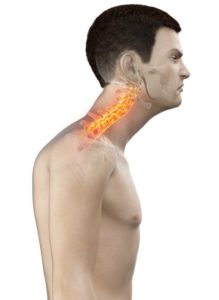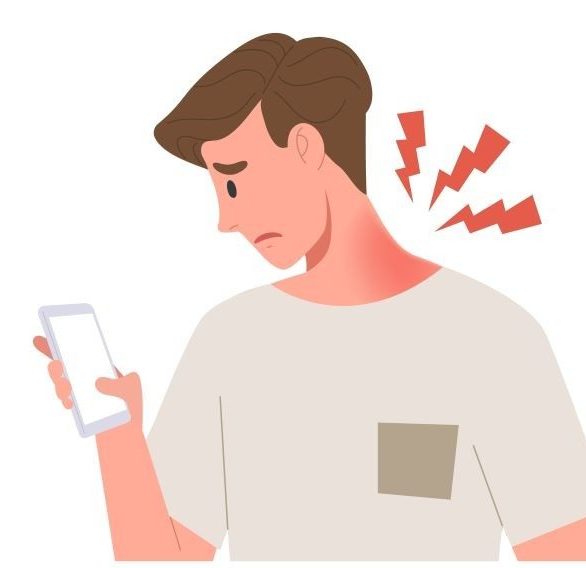 Have you ever heard of forward head posture? It is such a common posture these days that once you know about it, you will easily be able to recognize it in others. In this highly digital age, we spend long hours on our phones, tablets, and computers. Whether you are sitting or standing, you may even unconsciously lean into this forward head posture. A neutral spine and healthy posture involve your head resting above your shoulders with the underside of your chin parallel to the ground. In a forward head posture, your head is positioned slightly forward past your shoulders with your chin tilted down. While you might associate poor posture with things like car accident injuries, you can also experience issues with neck alignment in your everyday movements and behaviors. After a while, forward head posture can negatively impact you. Here’s what you need to know about fixing forward head posture so you can function at your best.
Have you ever heard of forward head posture? It is such a common posture these days that once you know about it, you will easily be able to recognize it in others. In this highly digital age, we spend long hours on our phones, tablets, and computers. Whether you are sitting or standing, you may even unconsciously lean into this forward head posture. A neutral spine and healthy posture involve your head resting above your shoulders with the underside of your chin parallel to the ground. In a forward head posture, your head is positioned slightly forward past your shoulders with your chin tilted down. While you might associate poor posture with things like car accident injuries, you can also experience issues with neck alignment in your everyday movements and behaviors. After a while, forward head posture can negatively impact you. Here’s what you need to know about fixing forward head posture so you can function at your best.
What Causes Forward Head Posture?
Maintaining proper neck posture requires you to pay attention to how you carry yourself and how you deal with pain and injuries. In order to fix neck posture, it helps to understand what is causing your forward head posture. Here are three common causes of forward head posture.
Poor Posture
The most common reason for forward head posture is engaging in poor posture. You might not even realize you have poor posture until you start paying attention to how you carry your body. Hunching forward over your computer for long hours at a time can lead to forward head posture. You can also develop poor head and neck posture from looking down at a phone or tablet in your hands. When you hold your head slightly forward with your chin tilted downward, it puts additional strain on the muscles that support your neck. The muscles along the back of your neck stretch to accommodate this position, while muscles underneath your chin become weaker with disuse. Poor posture can also contribute to developing a forward head posture if you drive hunched forward at the wheel for long periods of time or if you have a job or occupation that requires you to lean forward often.
Chronic Pain
If you have chronic pain in your neck, shoulders, or upper back, then this can cause you to tense and lean into a forward head posture without even realizing it. When you are in pain, one natural response can be to tense your body in response to the uncomfortable sensations. When you tighten or tense your shoulders, it can cause you to lift them toward your ears. This tension and discomfort in your neck can cause you to lean your head forward in an attempt to relieve the pressure and pain. You can even develop chronic pain from poor posture, like forward head posture.
Neck Injuries
Neck injuries can also lead to forward head posture. A car accident injury like whiplash causes neck muscles to strain or tear. The sudden force of impact from another vehicle can cause your head to snap violently forward and backward. When this happens, strained or torn neck muscles can cause pain, stiffness, and tenderness in your neck. A neck injury like whiplash can make it difficult to turn your head from side to side or up and down. If a certain position, like forward head posture, causes less pain while you heal from a whiplash injury, then you may be tempted to relax into this poor posture to help relieve your discomfort. However, your neck muscles and spine need you to engage in proper neck posture so that a whiplash injury can heal correctly.
How Forward Head Posture Affects You
 Forward head posture can cause a wide range of negative health benefits that you may not recognize right away. Many signs and symptoms of forward head posture may develop gradually as your neck muscles tighten and weaken, slowly losing their ability to effectively support your head and spine. Here are some examples of how forward head posture could affect you.
Forward head posture can cause a wide range of negative health benefits that you may not recognize right away. Many signs and symptoms of forward head posture may develop gradually as your neck muscles tighten and weaken, slowly losing their ability to effectively support your head and spine. Here are some examples of how forward head posture could affect you.
Chronic Poor Posture
If you constantly engage in forward head posture throughout your day, then your muscles will start to develop this habit of poor posture. When you wake up in the morning, it may be easier for you to slip into this poor posture without even realizing it. Chronic poor posture can cause pain and discomfort that affects healthy functioning in other parts of the body.
Spinal Misalignments
Poor posture can also contribute to misalignments in the spine. The vertebrae in your neck are stacked one on top of the other with spinal discs in between to help absorb shock. After a while, the stress and strain on your neck and spine from forward head posture can lead to slight misalignments of the vertebrae or spinal discs. Misalignments in the spine can cause uncomfortable symptoms like tingling and numbness.
Weakened Muscles
When you engage in forward head posture for long periods of time, it can cause muscles to become weakened from disuse. While the neck muscles along the back of your neck may stretch to accommodate this forward head posture, they may initially be too weak to support a healthy head and neck posture. The muscles underneath your chin and around the front of your neck can also become weak from disuse and lack of engagement.
Decreased Range of Motion
Forward head posture can also lead to a decreased range of motion in your head and neck. The muscles and tendons that support your neck will start to react to stress and strain by causing inflammation and tension in the area. You may start to notice your neck feels more stiff than normal. It can even become more uncomfortable to turn your head in certain directions. Forward head posture can also start to limit how far you can turn your head from side to side.
Headaches
You might be surprised to learn that chronic forward head posture can also cause headaches. Perhaps you started noticing an increase in headaches recently and couldn’t pinpoint why. It could be a response to forward head posture negatively impacting your spine. The spine houses the central nervous system, and misalignments or muscle strain and inflammation can disrupt healthy communication from the brain to the nerves throughout your body.
Jaw Pain
Jaw pain is also a common symptom of forward head posture. You may notice an increase in clenching or grinding your teeth, especially at night. This can come as a negative response to the pressure and strain on the neck muscles and soft tissues that connect to your jaws. Strain on your neck and forward head posture can put additional stress and pressure on your jaw joints, causing you to clench or grind your teeth as a natural response.
Tingling & Numbness
Anything that impacts your spine can also have an effect on your central nervous system. The central nervous system runs through the spinal canal with nerve endings that send signals to and from the brain throughout your body. A spinal misalignment or strained and inflamed nearby muscles can compress nerves along the spinal column. When nerves are aggravated or compressed, they can cause a pins and needles sensation. Tingling and numbness can start in your neck and radiate into your shoulders, arms, and hands.
Fixing Forward Head Posture
The first thing you want to do to help fix forward head and neck posture is to understand what correct posture feels like. Correct standing posture looks like your neck in a relaxed position to hold your head up between your shoulders. Your ears should be in line with your shoulders and hips. The spine should have a small, natural curve above the base of your neck, between your shoulder blades, and at your lower back. When you sit, correct sitting posture looks like holding your back straight but not too tense. You can still maintain a slight curve to your lower back when sitting with proper posture. Try to keep your chin parallel with the ground and your eyes looking straight ahead or slightly above you. Sleeping posture can also impact forward head posture. Check to make sure your pillows are supportive and help maintain a gentle curve of your spine. You don’t want to tuck your chin into your chest or twist your neck at a funny angle when you sleep.
Posture & Strengthening Exercises for Neck Posture
 Thankfully, there are many great exercises to help address forward head posture. Here are three examples of posture and strengthening exercises to help address text neck.
Thankfully, there are many great exercises to help address forward head posture. Here are three examples of posture and strengthening exercises to help address text neck.
Cervical Retraction
This is a posture exercise to help bring your head back into proper alignment with your cervical spine. Sit up straight in a chair with your eyes straight ahead and your chin parallel to the ground. Then tilt your chin very slightly toward your chest. Hold this tucked position and then press your head gently backward and up at a slight diagonal angle. Hold this stretch, relax, and then repeat.
Pectoral Stretches
You might be surprised to learn that stretching your pectoral muscles can help with forward head posture. This type of exercise can help expand your shoulders and bring them into better alignment so they can support a healthy head and neck posture. Face the corner of a wall and hold your arms out parallel to the ground with your elbows bent at a 90-degree angle. Then place your palms and forearms against the wall and gently lean your chest and torso toward the wall. You will feel a stretching feeling across your chest, like your chest and shoulders are opening.
Rhomboid Exercise
The rhomboid muscles help support your shoulder blades and pull them down, away from your ears. When you tense up your shoulders, they will naturally raise up toward your ears. A rhomboid exercise helps naturally pull your shoulders down and back to help reverse the forward head and hunched posture. Sit up straight with your arms above your head and grab onto each elbow gently. Then lift your arms over your head so that your upper arms are perpendicular to the ground and beside your ears. Once in this position, gently engage and release your upper body to help press your shoulder blades down.
Chiropractic Care for Forward Head Posture
 You can also visit your College Park chiropractor to learn more about how to fix neck posture. Chiropractors use all-natural and noninvasive approaches to help with poor posture, chronic pain, and injury recovery. Here are three ways a chiropractor can help with forward head posture.
You can also visit your College Park chiropractor to learn more about how to fix neck posture. Chiropractors use all-natural and noninvasive approaches to help with poor posture, chronic pain, and injury recovery. Here are three ways a chiropractor can help with forward head posture.
Reduce Pain
Chiropractors use gentle, therapeutic techniques to help reduce your pain and discomfort. Slight misalignments in the spine and strained or weakened neck muscles can lead to pain in your head, neck, and upper back. Chiropractors can use a combination of spinal adjustments, soft tissue mobilization, and therapeutic massage to help in reducing your pain and improving posture.
Resolve Misalignments
Chiropractic care may involve spinal adjustments that help resolve misalignments in the spine. Your chiropractor will use a hands-on approach or a noninvasive chiropractic tool that helps gently and effectively restore healthy alignment in your spine. When the spine is properly aligned, this will help resolve side effects of forward head posture like tingling and numbness.
Restore Healthy Posture
Your chiropractor will also work with you to strengthen your muscles to better support a healthy posture. Stretches and exercises can help you gain strength so your muscles can better stabilize your spine in a healthy posture. Talk to your College Park chiropractor to learn more about how they can help you restore healthy posture.
If you struggle with forward head posture, you are not alone! Don’t let chronic pain, TMJ pain, or other symptoms of forward head posture keep you from living your best life. Visit our team of chiropractors at AICA Orthopedics in College Park to get started today on training your body to better support a healthy posture and an even healthier you!